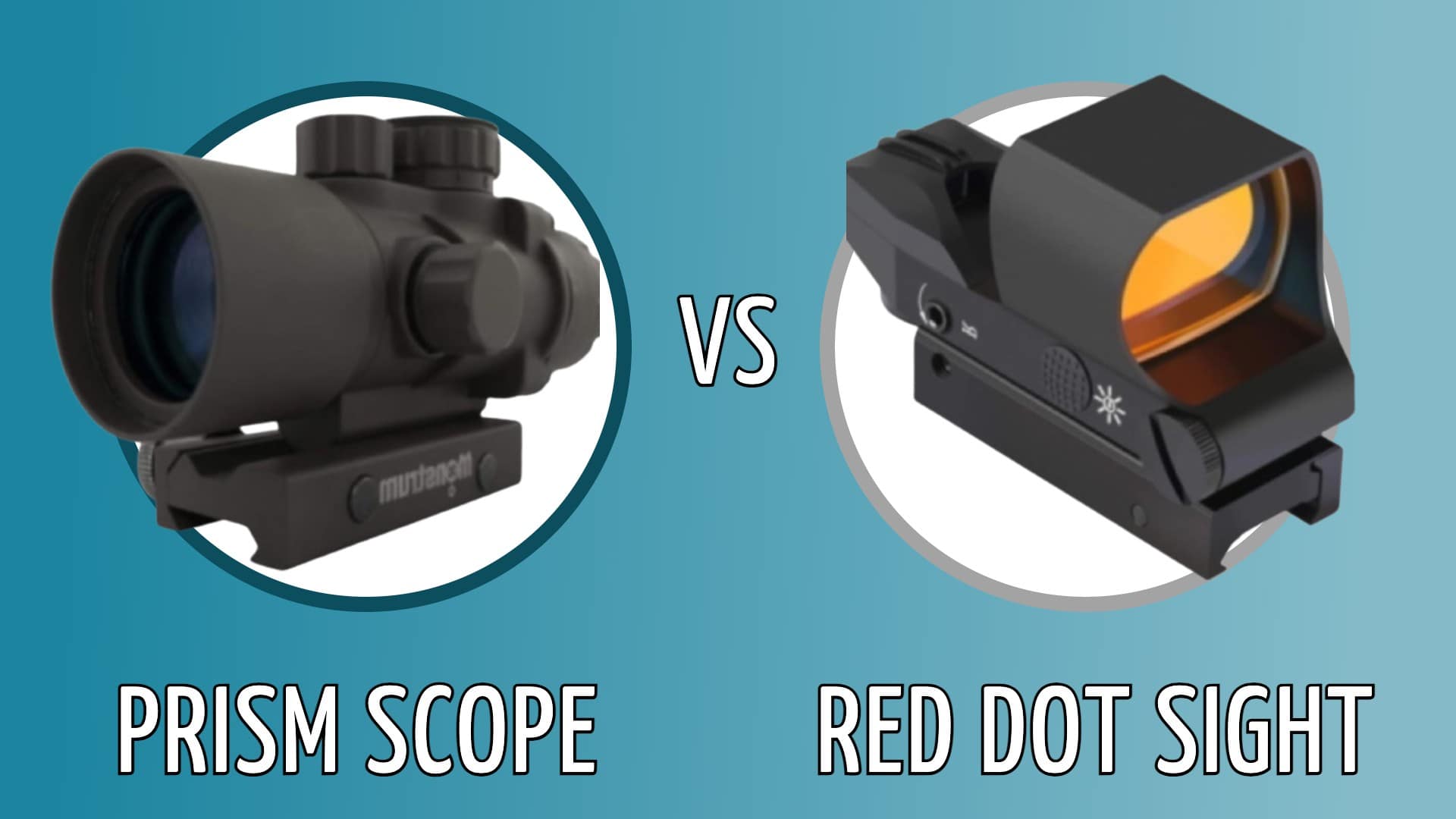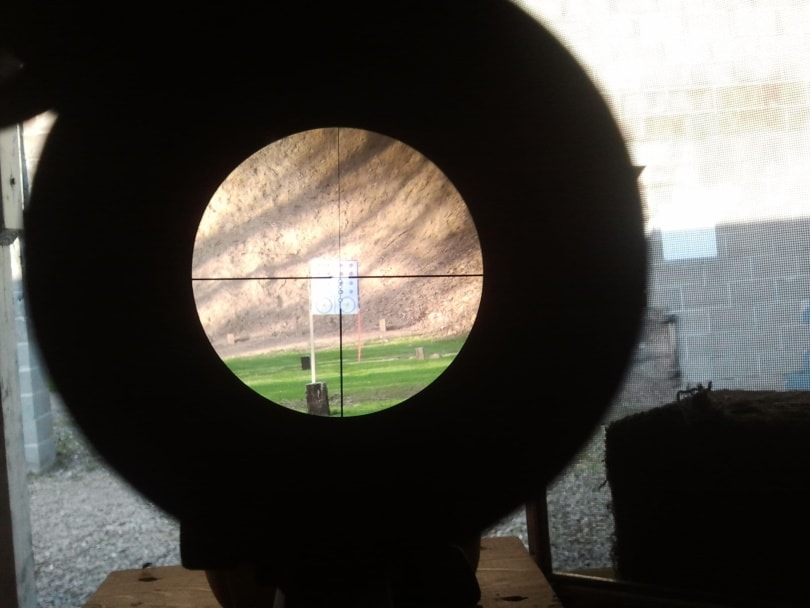Prism Scope vs Red Dot Sight: Which Is Better? A Complete Comparison
Last Updated on

The prism scope is the new kid on the block. And you can tell because not so many people know what exactly it does, or how different it is from the red dot sight. There’s some sort of gap in that flow of information, and we’re here to fill it.
So, today’s piece will be more of a comparison. Hopefully, by the time we get to the end, all your questions will be answered and you’ll know which scope is tailor-made for your adventures.

Prism Scopes: A General Overview
https://www.instagram.com/p/CErr7yOBSGZ/
A prism scope is not your conventional scope. So, if that was your immediate assumption, you’re wrong.
The way a typical rifle scope works is a lot similar to a classic telescope. These types of scopes have been designed to collect lots of light, and then focus whatever they’ve managed to collect on a particular point. Without getting into the nitty-gritty bits of the science behind it, this is how we would simply put it:
Light passes through the optic’s objective lens, which is located on the farthest end of the device, and to an ocular lens, which is the focus point.
Those are the basics in that system. Now, if you don’t mind, we’ll go back to the prism scope.
The prism scope, also referred to as a prismatic scope, is a lot different in the sense that it uses prisms to focus light. Hence, the name prism scope.
Due to their compact nature, manufacturers often find it easy adjusting and adding new features—The kind of features that you’d never find in a classic scope, owing to the fact that they lack enough room.
Something else that you’ll learn in due time is the number of benefits provided by a prism scope. They’ll offer you everything that your conventional scope can offer, and then some. We’re talking about eye reliefs, etched reticle, astigmatism, magnification powers, you name them.
You know, now that we’ve mentioned them, there’s no need to dilly-dally. Let’s just dive right in.
Magnification
As much as we’d love to just focus on the positives and not the negatives, we can’t ignore this aspect. The truth of the matter is prism scopes aren’t designed to offer variable magnification. And that’s a real bummer.
In fact, it’s the reason why you’re always advised to understand your needs before making a purchase. You really don’t want to buy a sighting device that offers zero value in the field. You’ll regret wasting your time and money.
Assuming you’re thinking of buying an optic that could help you clip a target that’s… say 300 yards away, your best bet would be to get a prism scope with a magnification power of 5x. That specification is more than enough if your ultimate goal is to get a clear shot at that distance. However, if we’re talking about free-hand or tactical shooting, a 1x or 2x magnifying scope will be the best fit.
Lenses

The types of lenses that you’ll find in a prism scope are no different from those designed for a conventional scope. So, the only difference will be the device that houses them.
Nowadays, most optic lenses come with some sort of coating. Some even have multiple layers of coating. The primary function of these coatings is to shield the lenses, and to a greater extent, the sight system against reflected light and glare. It’s practically impossible to find a scope that has been designed with lenses that don’t have anti-reflective coating.
And always remember; the more the layers, the better protected the prism scope is.
Reticle
https://www.instagram.com/p/BqSkEHxHcIv/
If we had to pick an area where the prism scope outshines all the other optics in the market, we would choose this one. It’s like this device was specifically designed to offer accommodation to different types of reticles.
Are you looking for a general-purpose prism scope? Try the one designed with a duplex reticle. Did you need one that could guarantee optimal performance in mid and long-range shooting? Give the Bullet Drop Compensator reticle a shot. And if all you want is a prism scope that offers low magnification power, the red-dot reticle has got you.
We also cannot fail to talk about the illuminated and etched reticle. Most prism scopes are designed with etched reticles. Something that you’ll appreciate if you’re the type of user who hates the thought of having to rely on illuminated reticles and power cells.
In a nutshell, if all you care about in a scope is the type of reticle it has or what it can do, ditch the traditional scope and go for the prism sight. And should the battery fail, you’ll still have the etched reticle feature on standby.
Brightness
https://www.instagram.com/p/CH6ibgIBEVG/
There’s a time we did a brightness comparison between prism scopes and all the other sighting devices in the market. Our finding just proved what we knew all along—their brightness level is unmatched.
Every single image produced was brighter than the ones created by all the other optics, even in ambient light conditions. And there was only one explanation for this. Prisms scopes are more efficient when it all boils down to light transmission. It was all we needed to figure out if this device was the appropriate tool for quick and easy target identification or acquisition.
Eye Relief
Would you say you’re the type of person who’s hung up on how wide the eye relief of a scope is? If the answer to that question is ‘Yes,’ you’ll for sure hate the prism scope. The hard truth is, we’ve never come across an optical device that offers an eye relief narrower than this one. And that means your eyes will always be very close to the scope.
Here’s the problem with that:
Say, you’re shooting with a rifle that has a heavy recoil. Ordinarily, you’ll need an eye relief of 5 inches, or something wider. Unfortunately, what the best a prism scope can do is to offer you 4 inches at most. That essentially means you’ll frequently deal with ‘scope bite.’
We would only recommend a prism scope on semi-automatic rifles. You know, the types that aren’t designed to use powerful ammunition.
Parallax
https://www.instagram.com/p/BtkGJnJFe6e/
Not even the best prism scope on the market can offer you a parallax-free experience. Even though they’re completely different from traditional scopes, they still deal with the same issues that plague their peers.
But there’s some good news: Those issues won’t be as extreme as they typically are when using a conventional scope.
No Co-Witnessing, But Great for Astigmatism
You won’t succeed aligning your iron sights with this device if that’s something that you’ve been planning. The only way you’ll be able to utilize those iron sights is by first detaching the scope from your rifle.
Concerning astigmatism, these bad boys have been designed with adjustable diopters that allow users who suffer from that condition to adjust the optic’s system to a point they feel most comfortable when focusing on an image.
- Compact
- Best at dealing with parallax
- Guarantees incredible brightness
- Accommodates different types of reticles
- Uses multi coated lenses
- Great for Astigmatism
- Doesn’t offer variable magnification
- No co-witnessing
- Narrow eye relief

Red Dot Sight: A General Overview

Why red dot? Well, the dot is in reference to the shape the reticle appears, while the red is the color of the dot itself. We also feel obligated to inform you that the phrase ‘Red Dot’ is more or less an umbrella term. We often use it when explaining or describing various sighting systems that produce similar effects. Let’s just say, if it’s designed to project a red reticle on a target, it’s most probably a red dot sight.
But that doesn’t necessarily mean that they all function the same way or share the same distinctive features. In general, we would say red dot sight fall in one of these three categories:
- Holographic
- Reflex sights
- Prismatic scopes
We’ve already discussed the prism scope, so there’s no need of going over that a second time.
Holographic
https://www.instagram.com/p/BrISbt9HtLj/
In some circles, they’re referred to as holographic diffraction sights. They’re very different from the other two optics in the sense that they’re non-magnified and only often utilize hologram reticles.
How’s that possible? Pretty simple, actually. First off, they’ll document the light being reflected off on the scene. They’ll then interpret that information, and then remodel the light field in the optic’s viewing area. Their reticles are mostly three dimensional, but if you like working with the two dimensional, they’re also easily accessible.
A holographic sight is not tubular in shape. This is yet another difference that you need to take a note of. It’s designed with a rectangular window, and that’s why users who prefer working with a wider field of view often find themselves gravitating towards it. The best part is, the way they’ve been designed makes it easy for users to move their heads around, without feeling the pressure of looking for a different aiming point.
Reflex
https://www.instagram.com/p/CMsbtg-pzBt/
Also known as reflector sights, they normally utilize LEDs to project dots onto their ocular lens. An ocular lens is the one nearest to the user’s eye, and it will act like a mirror substitute. Hence, the reason why the target’s image usually appears a tad bit darker than usual.
You should also know reflex sights come in two: there’s the tiny sight and one designed in a tubular shape. The former has an exposed beam, while the latter contains the beam. In addition, the tube-like reflex sight bears a resemblance to the short rifle scope.
What if you needed a reflex device that’s designed to utilize tritium for electronic projection? They’re also readily available. However, unless you consider yourself a tycoon, you’ll have to save enough money in order to get it. Those things don’t come cheap, pal.
Tritium is basically hydrogen, but in a radioactive form. When paired with phosphorus compounds, they have the ability to emit fluorescent light. We even have reflex sights that are designed to utilize fiber optic systems to power reticles. The type of technology incorporated into them is so advanced that they’re only appropriate for tactical situations.
Side Note: Using a reflex sight when hunting is advantageous because it doesn’t compromise peripheral vision. You’ll always feel at ease while focusing through its lenses.

Comparable Features of The Red Dot Sight
Compact Size
https://www.instagram.com/p/BWoy5DTAyo-/
The first thing that you’ll note the minute you hold a red dot sight in your hands is how simple they actually look. And if you get the ones that have a tubular shape, you’ll realize they’re similar in size to the Rifle Combat Optics and the Advanced Combat Optical Gunsight. The tiny red dot sight is so small that some people have even resorted to using them with their pistols. And guess what? They work perfectly.
Adjustability

“Can the windage and elevation be adjusted?” Yes, they can. And you’ll know this is no new feature if you’ve ever used one before. Setting up a proper zero for such a system is vital. You should know that by now. Most hunters prefer the Kentucky windage these days. This type of adjustment is meant to correct for wind by aiming the weapon to the target’s right or left rather than adjusting the sight itself.
Battery Life
These devices often use lasers and LEDs. And they’re very efficient because they allow their power cells to run for thousands of hours before draining out. They also know how to conserve energy as they automatically go to sleep mode when left idle for long hours. Extending the battery life is a possibility, but only if you use a solar panel.
Illuminated Reticles
https://www.instagram.com/p/B1IBbVVna6h/
As explained earlier, the red dot is created by an illuminated reticle. What’s responsible for illuminating this reticle will depend on what the manufacturer decided to use. It could either be a laser or an LED. And if you’re looking to make adjustments based on the light conditions or a personal preference, you could do so using a knob.
Chances are you’ll be tempted to work with a high brightness level. That’s okay but you also have to remember it will eventually strain your eye muscles.

Does This Mean the Red Dot Sight Has an Edge?
Well, the thing is, when it comes to a prism vs red dot, even though red dots are affordable and versatile, they aren’t everybody’s cup of tea. For starters, they don’t normally offer magnification, or any sort of optical distortion. You’ll only be able to see that red dot on the target, and that’s all. And you can definitely tell how this could become a problem, especially to a long-range shooter.
We can hear your thoughts. Right now, you’re wondering why anybody in his or her right mind would even consider purchasing a sighting device with zero magnification. You see, the answer is simple as always. It comes with a broader Field of View, thereby making target acquisition fast and easy.
https://www.instagram.com/p/Bhhws9eHRBT/
They are also effective over short distances, energy-efficient, and very reliable. As you would expect, their precision and accuracy are at an all-time low. But think about the speed advantage that you get to experience with follow-up shots. Wouldn’t you say it’s worth it?
The other negative point goes to the reticle-type found in the red dot sight. Compared to the prismatic scope, their reticles are not that advanced. That together with the fact that it lacks any magnification power means that the shooter will basically be doing a lot of guesswork.
- Energy efficient
- Wider Field of View
- Great speed advantage
- Illuminated reticles
- Compact size
- Windage and elevation adjustability
- Effective over short distances
- Lacks magnification power
- Reticles aren’t advanced

Conclusion – Prism Vs Red Dot
It’s time to wrap this up, guys. Before we go, we just want to remind you that whatever you decide to choose should be a device that you think will offer great value out there. Don’t pick something just because you want to look cool, or because everybody’s using it.
You might also be interested in some of our most favorite posts:
About the Author Robert Sparks
Robert’s obsession with all things optical started early in life, when his optician father would bring home prototypes for Robert to play with. Nowadays, Robert is dedicated to helping others find the right optics for their needs. His hobbies include astronomy, astrophysics, and model building. Originally from Newark, NJ, he resides in Santa Fe, New Mexico, where the nighttime skies are filled with glittering stars.
Related Articles:
Binocular Magnification Chart: Numbers & Distances Compared
How to Clean a Refractor Telescope: Step-by-Step Guide
How to Clean a Telescope Eyepiece: Step-by-Step Guide
What Is the Best Binocular Magnification for Hunting? Optical Features Explained
How to Clean a Rifle Scope: 8 Expert Tips
When Were Binoculars Invented? History, Today & Future
Monocular vs Telescope: Differences Explained (With Pictures)
What Is a Monocular Used For? 8 Common Functions
